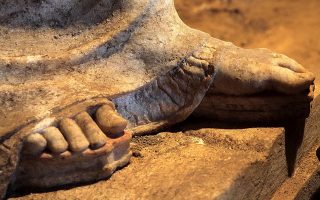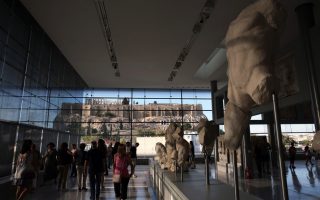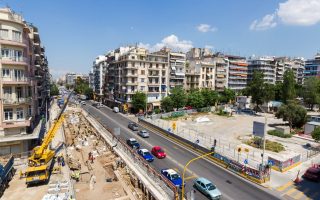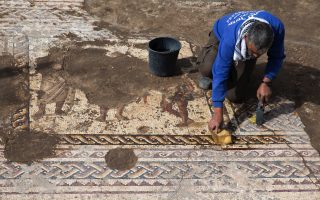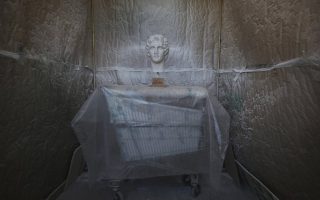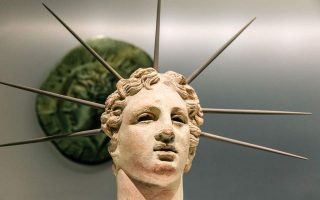Ancient temple seeks divine intervention
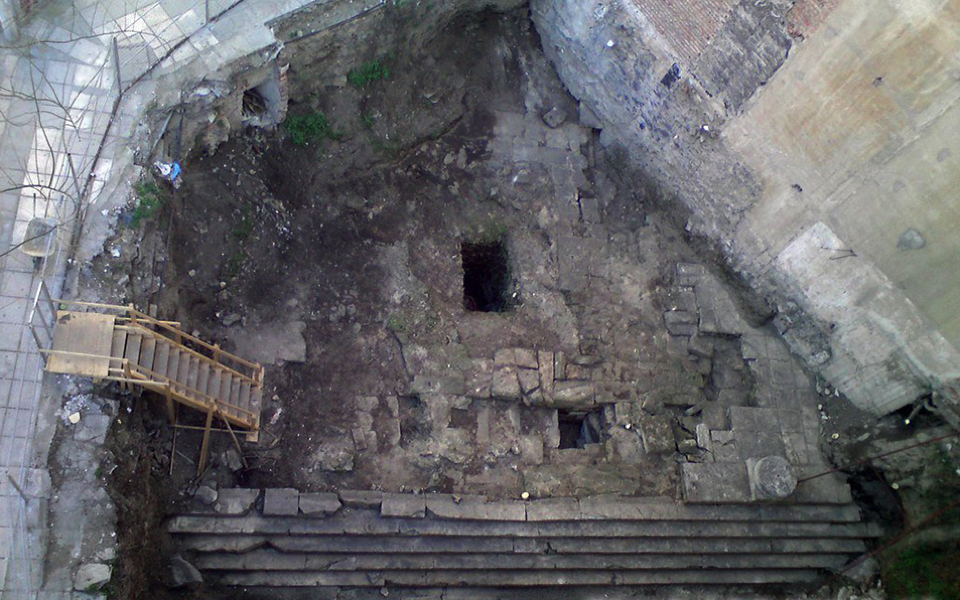
In a photograph from 1985, Maria Arabatzoglou poses along with her fellow students from the tour guide school at the Temple of Apollo Epicurius at Bassae, in the Peloponnese.
The impressive temple in Arcadia’s ancient Bassae, built between 420 and 400 BC, was among the school’s hottest exam topics, combining three architectural orders in one monument with many demanding constructional requirements for the era.
According to ancient traveler Pausanias, its completion was the work of Iktinos, the architect of the Parthenon, who had to come up with architectural solutions worthy of the famous Athenian monument, says Arabatzoglou as we ascend the winding road from Andritsaina, a nearby mountain village.
Since her time at university, Arabatzoglou has walked up this difficult road many times, leading Greek and foreign tourists to the temple. The first thing they see, as we do, is the protective installation that has sheltered the monument since 1987 to halt its deterioration from exposure to the elements.
“They understand that it was added to protect the monument for as long as work is being done, but the first thing they ask me is when it will be removed. And I jokingly respond, ‘It’s just been added,’” says Arabatzoglou.
A worn-out Culture Ministry sign showing the monument’s restoration stages welcomes us, along with a rusty electrical panel. Touch panels that never functioned are covered with black plastic, and a no-smoking sign completes the initial impression. As we move toward the perimeter of the colonnade, we see the “temporary” shelter is torn at various points, with pieces hanging from the roof, which is patched up in places.
Natural wear and tear
The roof, a lightning protection system and an earthquake-resistant scaffold specifically designed for the temple were considered “immediate rescue actions” to protect the monument and were designed by architect Iakovos Rigos. The damage to the roof is not unexpected, considering it has exceeded its expected life by 15 years, as Rigos explains in our telephone conversation. Archaeologists who have worked at the monument have been calling for a replacement of the covering for years. A tender that took place a few years ago was canceled and the funds earmarked for its replacement were lost.
The monument, which after Pausanias is next mentioned by travelers of the 18th and 19th century, is positioned at an altitude of 1,130 meters on Mount Kotylion, and is sometimes on the receiving end of extreme weather. Rainwater, snow and frost, the territorial peculiarities, as well as the detachment of metal and lead elements in the 19th century, which constituted the “adhesive material” of certain architectural segments, contributed to the deterioration of the monument, built mostly with limestone.
Arabatzoglou points out the problematic sections of the temple that are visible to the naked eye, such as the deviations of the columns, the capitals that have acquired a greenish color from damp, the sunken floor, the fractures on the steps and the height difference at the base of the temple compared to its west side.
There are also some static problems at the sections where no restoration work has been done, according to the head of Ilia’s Ephorate of Antiquities, Erofili-Iris Kolia, who added however that “there are no risks” of collapse.
One glance at the restored northern part of the monument where the main entrance of the temple is located shows the need to continue restoration work without interruption. So far, most of the restoration has been funded by European Union programs.
After the passive maintenance of the 1980s (roof, scaffold, lightning protection), restoration studies were approved by the Central Archaeological Council (KAS) in the mid-1990s, dividing the project into two major parts: the restoration of the peristasis and the cella (inner chamber of the temple). Work on the peristasis, that is, the perimeter colonnade, was divided into smaller projects, first being the northern part.
Work and funding
Work on the northern part of the temple began in early 2000 with the 3rd Community Support Framework (CSF) for Greece and was completed with the 2007-13 National Strategic Reference Framework (NSRF). Those who are acquainted with and keep a close eye on the endeavor closely speak of a mammoth project of discreet scientific work that is taking place for the first time in Greece, since, apart from the visibly restored sections of the temple (columns, capitals), archaeologists have had to work on the foundation, restoring hundreds of fragmented stones. The know-how gained may shorten the time required for work on the next phases of the project if the necessary funds are committed.
To secure the money required for the work, the Culture Ministry is again targeting EU funds. The new NSRF provides for the financing of projects for monuments under UNESCO protection and, as noted by the head of the Ephorate of Antiquities in Ilia, work is being done to have the temple included in the new program. The Temple of Apollo Epicurius was the first Greek monument to be included in the UNESCO list in 1986. While the monument is directly under the jurisdiction of the Culture Ministry, in several countries abroad the UNESCO National Committees play a much more active role in the management and use of listed monuments. Officials of UNESCO’s Greek Committee expressed concern to Kathimerini about the apparent lack of interest in the utilization of the monument, considering that 2018 is European Year of Cultural Heritage.
The temple combines some peculiarities that make up its uniqueness. Its northern orientation contrasts with the usual eastern orientation of ancient Greek temples, while architecturally it combines the Doric, Ionic and Corinthian orders. Its main decorative element is the inner marble Ionic frieze, which is currently at the British Museum.
The restoration video playing on a monotonous loop inside the temple is the only reminder of the work that stopped three years ago. All sides have expressed an intent to utilize the monument – the state and private initiatives such as the International Friends Association of the Temple of Apollo Epicurius.
The temple was dedicated to Apollo by the Phigalians, who believed the god had protected them from plague and invasion. Sometimes a divine intervention seems necessary.
